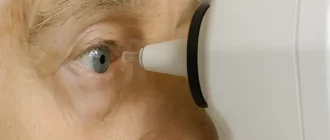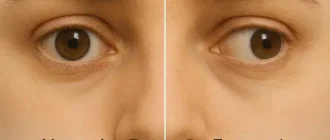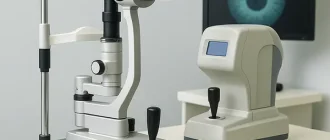With approximately 12 million Americans over the age of 40 living with vision impairment, eye health isn’t something to take lightly. Yet, it’s often overlooked until something goes wrong. From blurry vision to dry eyes and more serious conditions like macular degeneration, our eyes need regular care just like our heart or teeth.
Prevalence of Dry Eye Syndrome in US by Age Group
| Age Group | Prevalence (%) |
|---|---|
| 18–34 years | 2.7% |
| 35–54 years | 10% |
| 55–74 years | 30% |
| 75+ years | 18.6% |
This chart shows how the percentage of adults with dry eye syndrome increases with age. Middle-aged and older adults are particularly affected, indicating the importance of early eye care and preventive strategies.
Whether you’re glued to your screen or driving under the sun, your peepers are working overtime.
🧩 Eye Care Matrix
Simple eye care habits ranked by difficulty and effectiveness
Wear Sunglasses
Difficulty: Easy
Effectiveness: 8/10
Use a Humidifier
Difficulty: Moderate
Effectiveness: 6/10
Get Regular Sleep
Difficulty: Moderate
Effectiveness: 7.5/10
Annual Eye Exam
Difficulty: Demanding
Effectiveness: 9/10
Eat Leafy Greens & Omega-3s
Difficulty: Moderate
Effectiveness: 8/10
Follow 20-20-20 Rule
Difficulty: Easy
Effectiveness: 7.5/10
Source: eyexan.com
What Are the Most Common Eye Issues in the U.S.?
You might be surprised to know that refractive errors—like nearsightedness, farsightedness, and astigmatism—affect more than 150 million Americans. Dry eye syndrome, often exacerbated by screen time and low humidity, is another top contender. Then there’s age-related macular degeneration (AMD), glaucoma, and diabetic retinopathy—all of which can creep up without dramatic early symptoms ⧉.
Case in point: a 63-year-old woman from Phoenix, AZ, who believed her vision was just “getting old” ended up diagnosed with advanced AMD. Early detection could have slowed the progression.
🚫 What Hurts Your Eyes the Most?
Common daily habits ranked by how harmful they are to your vision
🔴 Rubbing Your Eyes
Damage Score: 8/10
Can lead to irritation, infections, and worsens keratoconus.
📵 Long Screen Time Without Breaks
Damage Score: 9/10
Increases digital eye strain and tear evaporation.
⏰ Poor Sleep
Damage Score: 7/10
Reduces tear production and eye muscle recovery.
🕶️ Direct Sunlight Without Protection
Damage Score: 9.5/10
Boosts risk of cataracts and retinal damage.
⚠️ Smoking
Damage Score: 10/10
Linked to macular degeneration and cataracts.
💧 Not Blinking Often
Damage Score: 6.5/10
Reduces tear film, causing dryness and irritation.
Source: eyexan.com
How Does Screen Time Affect Your Eyes?
Digital eye strain, also known as computer vision syndrome, is real. Symptoms include eye fatigue, blurred vision, headaches, and neck or shoulder pain. The American Optometric Association recommends the 20-20-20 rule: every 20 minutes, look at something 20 feet (about 6 meters) away for 20 seconds ⧉.
Screens emit blue light, which may contribute to retinal stress. While research is ongoing, some optometrists recommend blue light-blocking lenses, especially for those working 8+ hours a day in front of screens.
What Role Does Nutrition Play in Eye Protection?
Turns out, carrots really do help—sort of. Vitamin A supports retina health, but lutein, zeaxanthin, omega-3 fatty acids, and zinc play bigger roles in reducing the risk of chronic eye diseases ⧉.
Reyus Mammadli, medical consultant, emphasizes the importance of a nutrient-dense diet based on wholesome foods like dark leafy greens, orange vegetables, and fatty fish such as salmon or mackerel. “A clean, natural diet supports every layer of eye function,” he explains, “especially when paired with steady hydration and reduced processed sugar intake.”
Which Diagnostic Tools Help Catch Problems Early?
Here’s where tech meets vision. Let’s break down key tools:
- OCT (Optical Coherence Tomography): Uses light waves to capture 3D images of the retina. Accuracy: 9/10. Avg. cost: $150–$300
- Fundus Photography: Captures images of the back of the eye. Accuracy: 7.5/10. Avg. cost: $75–$200
- Visual Field Test: Measures peripheral vision. Accuracy: 8/10. Avg. cost: $40–$150
- Tonometry: Measures intraocular pressure (IOP) for glaucoma. Accuracy: 8.5/10. Avg. cost: $25–$75 ⧉
Early detection = better outcomes. Even if your vision seems fine, schedule a comprehensive eye exam at least every 1–2 years.
Prevalence of Major Eye Conditions in US Adults (40+)
| Condition | Prevalence (%) |
|---|---|
| Cataract | 17.2% |
| Glaucoma | 2.56% |
| Early AMD | 10% |
| Late AMD | 1% |
This bar chart demonstrates the prevalence of major eye conditions among US adults aged 40 and older. Cataracts and early-stage
What Are the Latest Treatments and Innovations?
Anti-VEGF Injections for Macular Degeneration
Anti-VEGF (vascular endothelial growth factor) therapy is used primarily to treat wet age-related macular degeneration (AMD) and diabetic macular edema. Medications like Lucentis (ranibizumab), Eylea (aflibercept), and Beovu (brolucizumab) are injected directly into the eye to reduce abnormal blood vessel growth and leakage in the retina. The procedure is done under local anesthesia in a clinical setting and takes less than 10 minutes. Frequency varies—often monthly at first, then less frequently.
- Effectiveness: 8.5/10
- Average Cost per Injection: $1,800–$2,400
Minimally Invasive Glaucoma Surgery (MIGS)
MIGS includes procedures like the iStent, Hydrus Microstent, and Trabectome, which help reduce intraocular pressure by improving fluid drainage. These are usually performed alongside cataract surgery. The surgery takes about 15–30 minutes and offers quicker recovery compared to traditional glaucoma surgeries.
- Effectiveness: 7.5–8/10
- Average Cost: $2,000–$4,000
Corneal Cross-Linking for Keratoconus
This procedure strengthens the cornea by applying riboflavin (vitamin B2) drops followed by controlled exposure to UV light. It’s a game-changer for patients with keratoconus, helping to halt disease progression. The treatment takes around 60–90 minutes.
- Effectiveness: 9/10
- Average Cost: $2,500–$4,000 per eye
Laser-Assisted Cataract Surgery with Premium IOLs
Modern cataract surgery has evolved with femtosecond lasers and premium intraocular lenses (IOLs) that correct not only cataracts but also refractive errors like astigmatism and presbyopia. The lens is removed and replaced through a tiny incision.
- Effectiveness: 9.5/10
- Average Cost: $3,500–$5,000 per eye
Tele-Optometry Services for Rural Access
Tele-optometry enables remote diagnosis and follow-ups through secure video calls and connected diagnostic devices. It’s particularly useful for patients in underserved areas or those with mobility issues.
- Effectiveness: 7/10 (for non-urgent assessments)
- Average Cost: $50–$150 per consult
These innovations are not just tech upgrades—they’re changing how vision is preserved, especially for chronic conditions. Reyus Mammadli notes, “Early access to high-tech care often means saving sight before it’s too late.”
How Can You Practice Everyday Eye Protection?
Protecting your eyes daily doesn’t require a medical degree or expensive tools—it’s about building simple habits that stick. Let’s unpack each strategy with practical tips:
- Wear UV-blocking sunglasses (100% UVA/UVB protection)
Sunlight contains ultraviolet rays that can damage the cornea and increase your risk for cataracts and macular degeneration. Think of UV rays like invisible lasers. Over time, they cook your lens. Wearing sunglasses labeled “100% UV protection” or “UV400” helps block both UVA and UVB rays. Expect to pay $15–$200 depending on brand and prescription needs. Polarized lenses reduce glare, especially useful for driving or fishing. - Use safety goggles when working with chemicals or power tools
Whether you’re sanding wood or using bleach, particles and splashes can cause serious eye injury in seconds. Safety goggles form a protective seal around your eyes, unlike regular glasses. You can find ANSI-rated goggles (look for Z87 marking) for $5–$25 at most hardware stores. It’s cheaper than a trip to the ER. - Keep screens 20–24 inches (50–60 cm) from your face
Sitting too close to your screen can cause strain. Ideally, your monitor should be an arm’s length away, with the top of the screen at or just below eye level. Use a monitor riser or stack of books if needed. This helps maintain proper posture and visual focus. - Adjust lighting to reduce glare
Ever feel like you’re squinting at your screen under a desk lamp? That’s glare at work. Use matte screen protectors and indirect light sources. Position screens so that windows and lights don’t reflect off the surface. Task lighting (adjustable desk lamps) with warm LED bulbs works wonders. - Stay hydrated and use humidifiers in dry climates
Dehydration affects tear production. Without enough tears, your eyes feel dry, itchy, or sandy. Drink 8–10 glasses of water daily. In dry climates or heated rooms, a cool mist humidifier ($30–$80) helps maintain eye-friendly humidity levels. Add it to your bedside or workspace. - Don’t rub your eyes—seriously
Rubbing your eyes may feel satisfying, but it can transfer bacteria and lead to irritation or even corneal damage. It also worsens conditions like keratoconus. Use preservative-free artificial tears if your eyes itch. These drops cost about $5–$15 and offer relief without harm. - Wash your hands before touching your lenses
Contact lens wearers, this one’s for you. Your fingers carry oils, bacteria, and allergens. Washing hands with soap and water before handling lenses reduces the risk of eye infections like conjunctivitis. Use a lint-free towel to dry them. Consider this a non-negotiable habit.
Each of these steps is like a seatbelt for your eyes—not flashy, but incredibly effective when things get risky.
How Do Age and Lifestyle Affect Eye Health?
Aging naturally reduces elasticity in the lens and moisture production. But lifestyle choices—from smoking (big no-no!) to sedentary habits—can accelerate decline. Regular physical activity and proper hydration improve blood circulation, including to the eyes ⧉.
Take, for instance, a 45-year-old male from Charlotte, NC, who switched to a plant-heavy diet and started jogging daily. Six months in, his eye pressure normalized, and his dry eye symptoms significantly improved.
US Adults Living with AMD
| AMD Stage | Estimated Number (Million) |
|---|---|
| Early AMD | 18 million |
| Late AMD | 1.49 million |
This chart compares the number of US adults aged 50+ living with early and late stages of age-related macular degeneration (AMD). The vast majority are in the early stage, underscoring the importance of early diagnosis and monitoring to prevent progression.
What Can Parents Do to Protect Kids’ Vision?
With kids spending more than 7 hours daily on screens, early eye care is crucial. Pediatric eye exams, screen-time limits, and outdoor play (at least 1–2 hours daily) are essential ⧉.
Plus, blue light filters and larger font sizes help reduce strain. Reyus Mammadli emphasizes, “Childhood is a critical window for visual development. Don’t wait for complaints—act early.”
Editorial Advice
Regular eye checkups, balanced nutrition, screen breaks, and UV protection aren’t just good ideas—they’re essential strategies. The eyes might not always scream for attention, but they reveal much about our overall health.
Reyus Mammadli, medical consultant, recommends incorporating eye care into annual health routines, just like a dental or physical checkup. “Vision is a gift—protect it with intent,” he says. Smart habits now can prevent costly problems later. So give your eyes the TLC they deserve—after all, you only get two.





